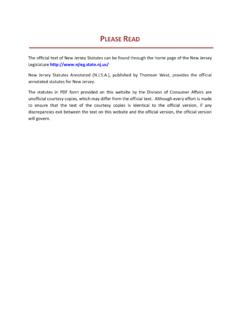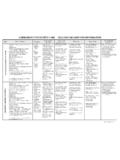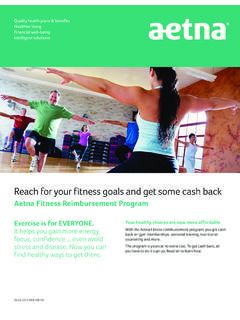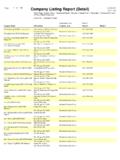Transcription of Yoga Club Teacher Training Manual Restorative Yoga
1 yoga club Teacher Training Manual Restorative yoga Page 1 Restorative yoga Rest & Restore Your Body, Renew Your Spirit Chrys Kub, Physical Therapist, E-RYT 500 yoga club Teacher Training yoga club Teacher Training Manual Restorative yoga Page 2 What is Restorative yoga Let's face it: Some yoga poses are just delicious. And if yoga were a buffet, Restorative postures would most definitely be at the dessert table. Restorative poses are soothing and well-supported and offer the opportunity to linger quietly for a few moments to savor the sweet stillness. In an ideal world every asana in our practice would feel Restorative , but poses that fall into the Restorative category have a unique ability to leave us feeling nourished, well rested, and restored.
2 Traditionally, yoga classes and home practices begin with active postures followed by a brief Restorative posture or two. The development of Restorative postures is largely credited to Iyengar, of Pune, India. Iyengar has been teaching yoga for more than sixty years and is widely recognized as a worldwide authority. Iyengar's early teaching experience revealed how pain or injury can result from a student straining in a yoga pose. To alleviate this, he experimented with "props," modifying each pose to each student s body such that the student could practice without strain. Judith Lasater, , and one of the foremost teachers of Restorative yoga , often refers to Restorative yoga poses as "active relaxation." By supporting the body with props, Restorative yoga alternately stimulates and relaxes the body to help us move toward balance.
3 Some postures have an overall benefit while others target an individual body part. However each pose creates a specific physiological response which is beneficial to our health and can reduce the effects of stress-related diseases. Restorative postures are usually deeply supported with props including blankets, blocks, bolsters, straps, and chairs. Postures are normally held for several minutes. In general, Restorative yoga poses are best used at times when you feel weak, fatigued, or stressed from daily activities. These poses are especially beneficial before, during, and after major life events: death of a loved one, change of job or residence, marriage, divorce, major holidays, and vacations. In addition, you can practice the poses when ill, or recovering from illness or injury.
4 The Purpose of Restorative yoga To support the body with props providing active relaxation To alternately stimulate and relax the body to move toward balance To create specific physiological responses which are beneficial to health and reduce the effects of stress To create muscular release, not the sensation of a stretch Mechanisms of Restorative yoga Relieves the effects of stress through supported relaxation Moves the spine in all directions Provides an inversion which reduces the effects of gravity Alternately stimulates and soothes the organs (compression/release) Balances the energies of prana (upward energy) and Apana (downward energy) Stimulates the parasympathetic nervous system; enhancing homeostasis Use of Props Props can be used for support to prop up or support the shape of a pose from below or to anchor or stabilize the shape of a pose preventing effort and movement.
5 Blocks: to support a body part yoga club Teacher Training Manual Restorative yoga Page 3 Precaution: determine when the block needs to be stable or slide on the floor Nonskid mats: can be rolled or folded to take the place of a blanket Pillow/folded towel: to use under the heels or support the neck yoga Straps: Recommend 8-10 foot straps with a D ring for ease of use Precaution: when locking straps, make sure there is adequate circulation. Discoloration of the skin (red or white) indicates loss of blood flow. Eye bags: small rectangular cloth bag made of silk or soft cotton, filled with uncooked rice, flax seeds or washable plastic beads Precaution: carefully let the front of the eye bag fall toward the nose, not on the nose Eye Wrap: elastic bandage four inches wide, carefully wrapped around the head, starting at the base of the skull to provide slight compression Blankets: When used for a cover can be any type.
6 When used as support, recommend firm cotton or wool blankets Standard Fold twin Practice Folding Blankets: 1) Standard Fold 1 x 21 x 28: Fold open blanket in half 3x 2) Single Fold x 10 x 28 Standard Fold, fold in half lengthwise 3) Double Fold 5 x x 28 Standard Fold: two folds lengthwise 4) Long Roll 5 x 6 x 28 Standard Fold, start at long folded edge and roll blanket Bolster: recommend it weigh about 7 lbs and be stuffed with dense cotton. 2 feet long with a diameter of 9 inches with a removable cotton cover Folding Metal Chair: chair with an open back rest is ideal to allow legs to be placed through it Wall: Access to a wall for supported poses Weighted Sand Bags: 10 lbs Principals of Restorative yoga Sensation of the pose should not be a wham Sensation should be slowly building Sensation should not be collecting in one place In each pose, seek to add length or fill in the space OR talk length away and take props away yoga club Teacher Training Manual Restorative yoga Page 4 DEMO: Supine Butterfly/Supta Baddakonasana Imagine the apex of the pose and a waterfall of energy moving in all directions.
7 ~ Leeann Carey Breath: should be easy and gentle, never forced or strained. It is recommend to use nose breathing Prep poses: understand which poses prepare for other poses PREPARATORY POSE POSE Lateral Bends Standing, poses, Forward bends and Backbends Standing All Back bends Twists and Inversions Twists Back bends Forward Bends Standing and inversions Savasana All Counterposes: understand which poses return the spine to a neutral position Counter Balance (Neutral Spinal Position) Pose Lateral Bends Forward Bends Standing Forward Bends Standing Lateral Bends Backbends Twists followed by forward bends Inversions Forward bends Twists Forward Bends Forward Bends Savasana Pose Duration Pose Duration in Minutes Lateral Bends 1 Minute, Gradually increase to 3 Standing 2 Minutes, Gradually increase to 4 Backbends 2 Minutes, Gradually increase to 10 Inversions 2 Minutes, Gradually increase to 15 Twists 3 Minutes, Gradually increase to 5 Forward Bends 3 Minutes, Gradually increase to 10 Savasana 7 Minutes, Gradually increase to 20 yoga club Teacher Training Manual Restorative yoga Page 5 Adjustments in the poses should Reduce sharp angles in the body Go to the biggest joint first.
8 For example the thigh instead of the knee Monitor that the following does not occur Falling backward or behind the head with neck hyper extension Collapsing downward in the mid-thoracic spine in a forward bend Laterally flexing the neck in a twist Hyper extension in the cervical spine or lumbar spine in an inversion Types of Restorative Poses Restorative ACTIVE POSES Designed to awaken dull areas in the body to improve circulation and encourage healing Stimulates the internal organs as in a twist Forward Folds: Standing Forward Fold Pose/Uttanasana Backbends: Reclining Hero/Supta Virasana Camel Pose/Ustrasana Two Legged Inverted Staff Pose/Viparita Dandasana Inversions: Downward Facing Dog Variations 1 and 2 Head Balance Pose Supine: Supine Bound Angle Pose Restorative INACTIVE POSES Designed to induce a state of deep relaxation and recuperation Savasana is the base of all RIP poses Backbends: Fish Pose (Matsyasana) Variation 1 and 2 Supported Bridge Pose Inversions: Elevated Legs Up the Wall Forward Bends: yoga club Teacher Training Manual Restorative yoga Page 6 Seated Angle Pose Head to Knee Pose Seated Forward Fold Prone: Child s Pose (Downward Facing Hero Pose) Spinal Twist (Revolved Squeeze Pose) Supine: Supine Bound Angle Pose Lying Down Big Toe Pigeon Pose (One Foot Easy Pose) Belly Twisting Pose Inversion: Elevated Legs Up the Wall Savasana Sequencing f or Restorative yoga Initiation.
9 Start with calming breathing practices, setting an intention for the first few minutes. Spend the next 5 -10 minutes with gentle movement to warm the body and prepare for relaxation. Sequence: Depending on your population and their needs. A general Restorative class should be balanced with the spine moving in all directions. Beginning with shorter times in each pose and ending with longer periods. If your students have particular issues, you can focus on poses that address their individual needs. Sample Sequences: General Sequence ~ from Judith Lasater Relax and Renew Restorative Fish 1 minute Supine Bound Angle Pose 10- 15 minutes Supported Bridge Pose 15 minutes Elevated Legs Up the Wall 15 minutes Prone Spinal Twist 3 minutes Supported Seated Angle Pose 3 minutes Supported Seated Forward Fold Easy Seated Legs 3 minutes Basic Relaxation Pose with Legs Elevated 5 20 minutes Woman s Restorative Sequence ~ from Patricia Walden The Woman s Book of yoga and Health Reclining Bound Angle Pose 5 minutes Reclining Easy Seated Pose 5 minutes Reclining Big Toe Pose (Leg Up and Leg to Side)
10 1 minute each Downward Facing Dog 1 minute yoga club Teacher Training Manual Restorative yoga Page 7 Child s Pose 3 minutes Head on Knee Pose 3 minutes Seated Forward Bend Pose 3-5 minutes Shoulder Stand Pose 3-5 minutes Plow Pose 3-5 minutes Supported Bridge Pose 5-10 minutes Supported Legs Up the Wall Pose o Cycle ~ Legs Straight Up 5 minutes o Legs Wide 3-5 minutes o Cross Legs 3-5 minutes o Flat on Floor Crossed Legs 5 minutes Restorative yoga for Athletes ~ Sequence adapted from BKS Iyengar The Path to Holistic Health Fish Pose Variation 1 5 minutes Reclining Bound Angle Pose 5 minutes Reclining Hero s Pose 3 minutes Lying Down Big Toe(Leg Up and Side) 1 minute each Chlid s Pose 3 minutes Head on Knee Pose 3 minutes each side Seated Forward Fold 5 minutes Lying Down Twist 3 minutes each side Cow Face Arm Stretch 1 minute each Downward Facing Dog 1 minute Standing Forward Fold 2 minutes Supported Bridge 5 minutes Elevated Legs Up the Wall 10 minutes Savasana 10-15 minutes REFERENCES: yoga Therapy: Restorative yoga Manual by Leeann Carey of Relax and Renew: Restful yoga for Stressful Times by Judith Lasater PhD, PT Rodmell Press, Berkeley, CA 1995, 2011 The Woman s Book of yoga and Health: A Lifelong Guide to Wellness by Linda Sparrowe and Patricia Walden Shambala Publications 2002 yoga : The Path to Holistic Health yoga .









